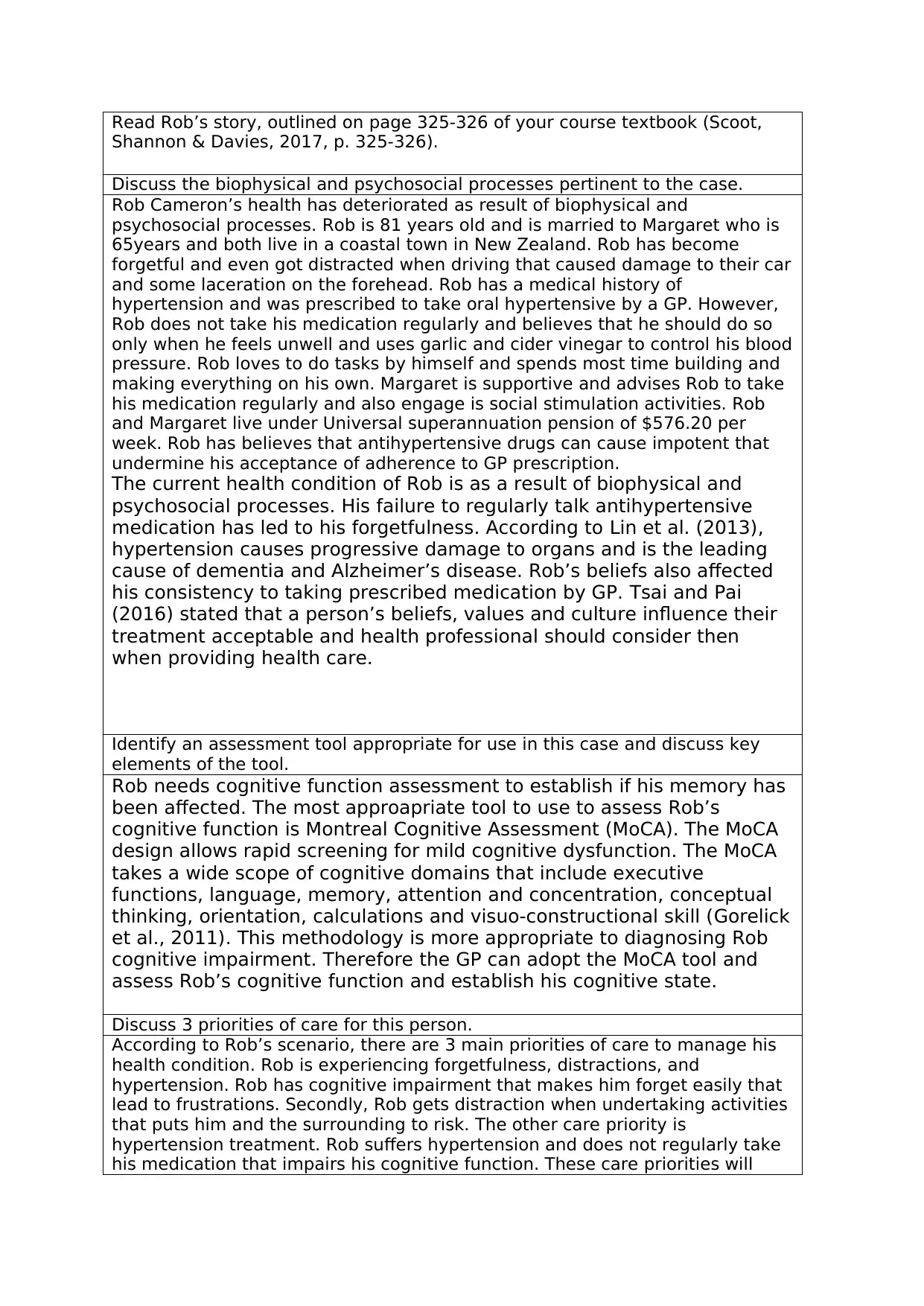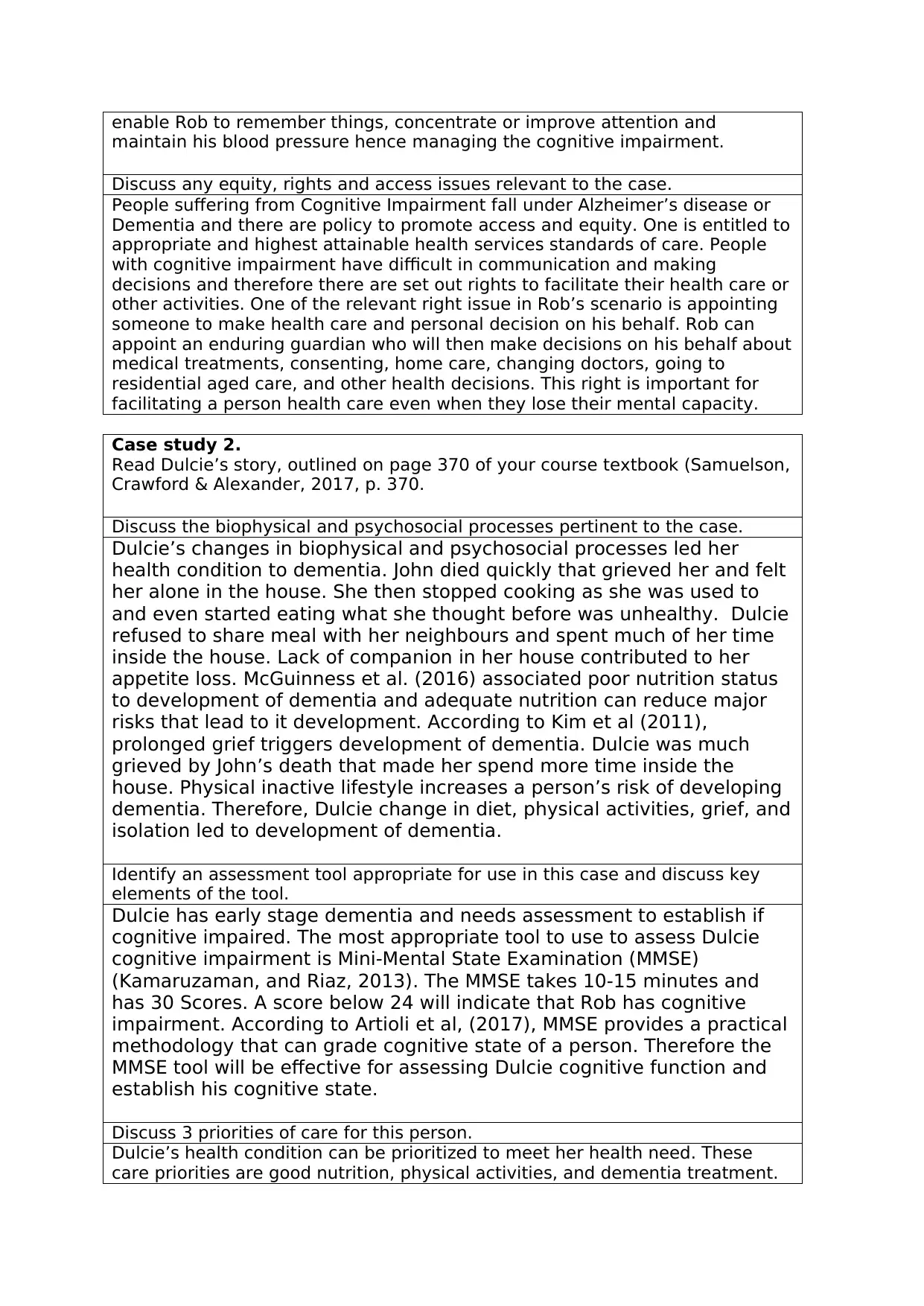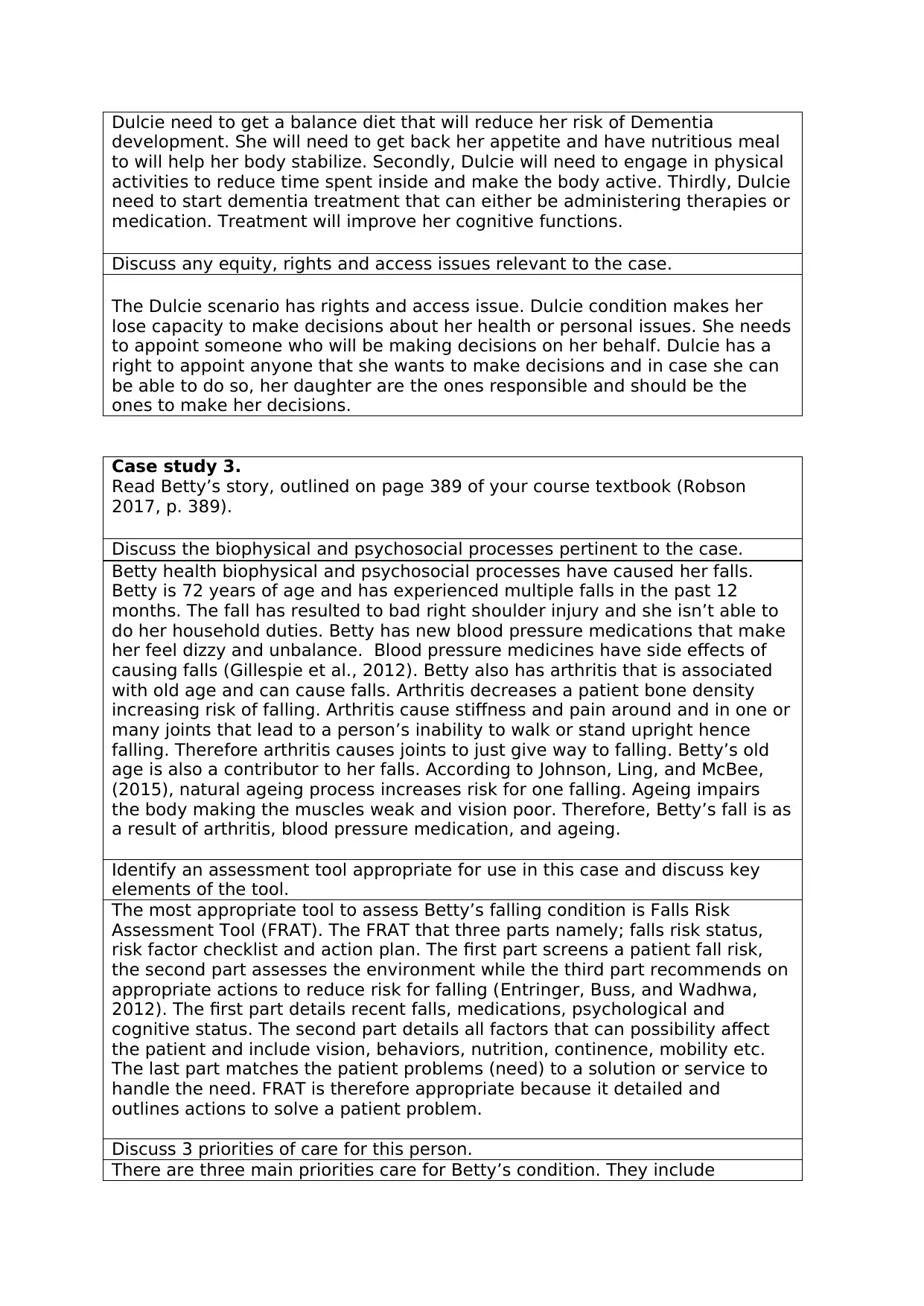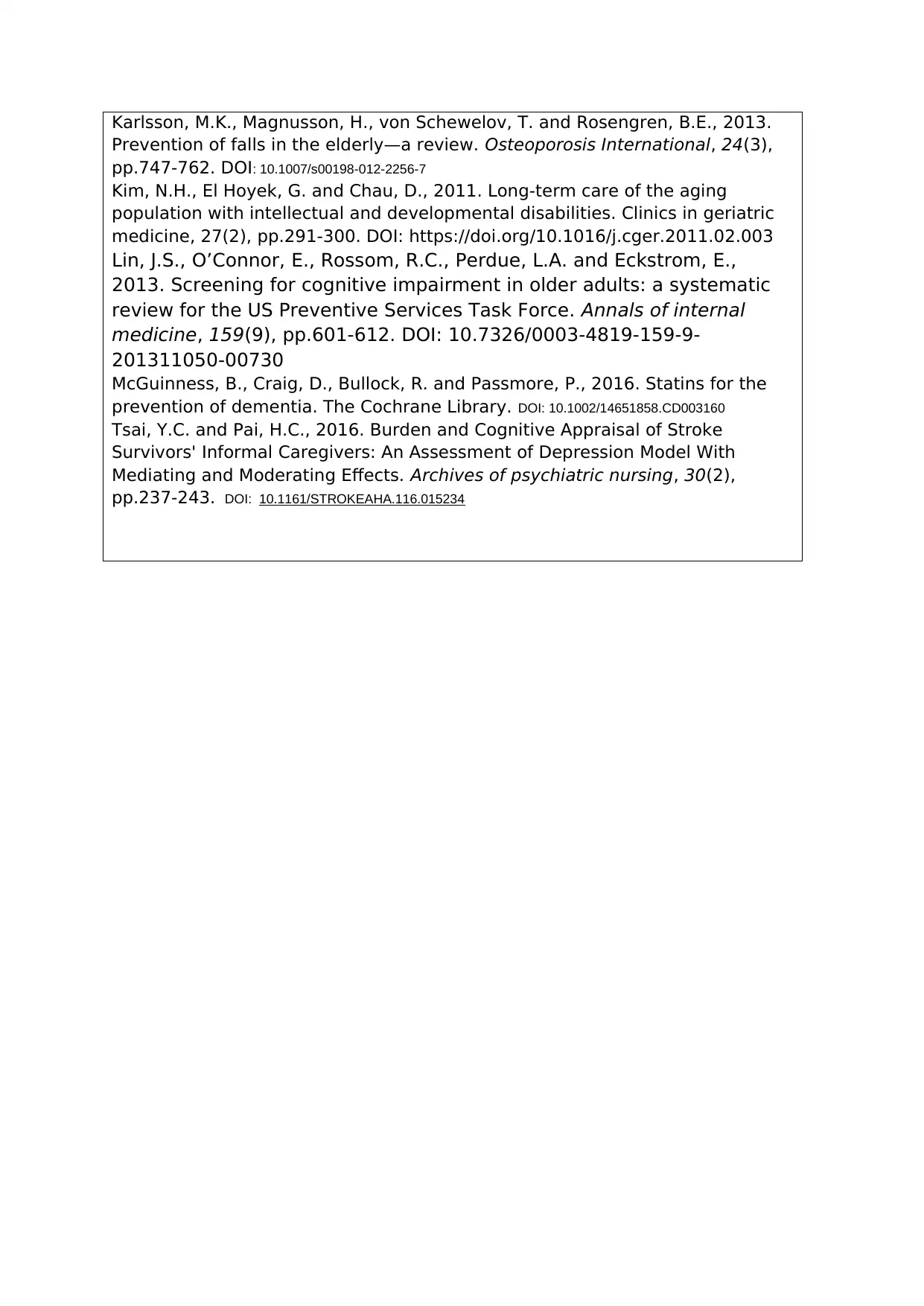NUR104 Assessment 3: Analyzing Cases with Priorities of Care
VerifiedAdded on 2023/06/03
|6
|2526
|494
Case Study
AI Summary
This assignment presents a case study analysis focusing on the biophysical and psychosocial processes affecting patient health. It examines three distinct cases—Rob, Dulcie, and Betty—detailing their respective health conditions and the pertinent factors contributing to their deterioration. The analysis includes identifying appropriate assessment tools such as the Montreal Cognitive Assessment (MoCA), Mini-Mental State Examination (MMSE), and Falls Risk Assessment Tool (FRAT) for each case, along with discussing key elements of these tools. Furthermore, the assignment outlines three priorities of care for each individual, addressing issues like cognitive impairment, dementia, and fall risks. Finally, it discusses equity, rights, and access issues relevant to each case, emphasizing the importance of patient autonomy and access to quality healthcare. This assignment provides a comprehensive overview, and Desklib offers a platform to access more solved assignments and study resources.

UNIT:
NAME:
DATE:
NUR104 Assessment Task 3: Case study 40%
Case study 1.
NAME:
DATE:
NUR104 Assessment Task 3: Case study 40%
Case study 1.
Paraphrase This Document
Need a fresh take? Get an instant paraphrase of this document with our AI Paraphraser

Read Rob’s story, outlined on page 325-326 of your course textbook (Scoot,
Shannon & Davies, 2017, p. 325-326).
Discuss the biophysical and psychosocial processes pertinent to the case.
Rob Cameron’s health has deteriorated as result of biophysical and
psychosocial processes. Rob is 81 years old and is married to Margaret who is
65years and both live in a coastal town in New Zealand. Rob has become
forgetful and even got distracted when driving that caused damage to their car
and some laceration on the forehead. Rob has a medical history of
hypertension and was prescribed to take oral hypertensive by a GP. However,
Rob does not take his medication regularly and believes that he should do so
only when he feels unwell and uses garlic and cider vinegar to control his blood
pressure. Rob loves to do tasks by himself and spends most time building and
making everything on his own. Margaret is supportive and advises Rob to take
his medication regularly and also engage is social stimulation activities. Rob
and Margaret live under Universal superannuation pension of $576.20 per
week. Rob has believes that antihypertensive drugs can cause impotent that
undermine his acceptance of adherence to GP prescription.
The current health condition of Rob is as a result of biophysical and
psychosocial processes. His failure to regularly talk antihypertensive
medication has led to his forgetfulness. According to Lin et al. (2013),
hypertension causes progressive damage to organs and is the leading
cause of dementia and Alzheimer’s disease. Rob’s beliefs also affected
his consistency to taking prescribed medication by GP. Tsai and Pai
(2016) stated that a person’s beliefs, values and culture influence their
treatment acceptable and health professional should consider then
when providing health care.
Identify an assessment tool appropriate for use in this case and discuss key
elements of the tool.
Rob needs cognitive function assessment to establish if his memory has
been affected. The most approapriate tool to use to assess Rob’s
cognitive function is Montreal Cognitive Assessment (MoCA). The MoCA
design allows rapid screening for mild cognitive dysfunction. The MoCA
takes a wide scope of cognitive domains that include executive
functions, language, memory, attention and concentration, conceptual
thinking, orientation, calculations and visuo-constructional skill (Gorelick
et al., 2011). This methodology is more appropriate to diagnosing Rob
cognitive impairment. Therefore the GP can adopt the MoCA tool and
assess Rob’s cognitive function and establish his cognitive state.
Discuss 3 priorities of care for this person.
According to Rob’s scenario, there are 3 main priorities of care to manage his
health condition. Rob is experiencing forgetfulness, distractions, and
hypertension. Rob has cognitive impairment that makes him forget easily that
lead to frustrations. Secondly, Rob gets distraction when undertaking activities
that puts him and the surrounding to risk. The other care priority is
hypertension treatment. Rob suffers hypertension and does not regularly take
his medication that impairs his cognitive function. These care priorities will
Shannon & Davies, 2017, p. 325-326).
Discuss the biophysical and psychosocial processes pertinent to the case.
Rob Cameron’s health has deteriorated as result of biophysical and
psychosocial processes. Rob is 81 years old and is married to Margaret who is
65years and both live in a coastal town in New Zealand. Rob has become
forgetful and even got distracted when driving that caused damage to their car
and some laceration on the forehead. Rob has a medical history of
hypertension and was prescribed to take oral hypertensive by a GP. However,
Rob does not take his medication regularly and believes that he should do so
only when he feels unwell and uses garlic and cider vinegar to control his blood
pressure. Rob loves to do tasks by himself and spends most time building and
making everything on his own. Margaret is supportive and advises Rob to take
his medication regularly and also engage is social stimulation activities. Rob
and Margaret live under Universal superannuation pension of $576.20 per
week. Rob has believes that antihypertensive drugs can cause impotent that
undermine his acceptance of adherence to GP prescription.
The current health condition of Rob is as a result of biophysical and
psychosocial processes. His failure to regularly talk antihypertensive
medication has led to his forgetfulness. According to Lin et al. (2013),
hypertension causes progressive damage to organs and is the leading
cause of dementia and Alzheimer’s disease. Rob’s beliefs also affected
his consistency to taking prescribed medication by GP. Tsai and Pai
(2016) stated that a person’s beliefs, values and culture influence their
treatment acceptable and health professional should consider then
when providing health care.
Identify an assessment tool appropriate for use in this case and discuss key
elements of the tool.
Rob needs cognitive function assessment to establish if his memory has
been affected. The most approapriate tool to use to assess Rob’s
cognitive function is Montreal Cognitive Assessment (MoCA). The MoCA
design allows rapid screening for mild cognitive dysfunction. The MoCA
takes a wide scope of cognitive domains that include executive
functions, language, memory, attention and concentration, conceptual
thinking, orientation, calculations and visuo-constructional skill (Gorelick
et al., 2011). This methodology is more appropriate to diagnosing Rob
cognitive impairment. Therefore the GP can adopt the MoCA tool and
assess Rob’s cognitive function and establish his cognitive state.
Discuss 3 priorities of care for this person.
According to Rob’s scenario, there are 3 main priorities of care to manage his
health condition. Rob is experiencing forgetfulness, distractions, and
hypertension. Rob has cognitive impairment that makes him forget easily that
lead to frustrations. Secondly, Rob gets distraction when undertaking activities
that puts him and the surrounding to risk. The other care priority is
hypertension treatment. Rob suffers hypertension and does not regularly take
his medication that impairs his cognitive function. These care priorities will

enable Rob to remember things, concentrate or improve attention and
maintain his blood pressure hence managing the cognitive impairment.
Discuss any equity, rights and access issues relevant to the case.
People suffering from Cognitive Impairment fall under Alzheimer’s disease or
Dementia and there are policy to promote access and equity. One is entitled to
appropriate and highest attainable health services standards of care. People
with cognitive impairment have difficult in communication and making
decisions and therefore there are set out rights to facilitate their health care or
other activities. One of the relevant right issue in Rob’s scenario is appointing
someone to make health care and personal decision on his behalf. Rob can
appoint an enduring guardian who will then make decisions on his behalf about
medical treatments, consenting, home care, changing doctors, going to
residential aged care, and other health decisions. This right is important for
facilitating a person health care even when they lose their mental capacity.
Case study 2.
Read Dulcie’s story, outlined on page 370 of your course textbook (Samuelson,
Crawford & Alexander, 2017, p. 370.
Discuss the biophysical and psychosocial processes pertinent to the case.
Dulcie’s changes in biophysical and psychosocial processes led her
health condition to dementia. John died quickly that grieved her and felt
her alone in the house. She then stopped cooking as she was used to
and even started eating what she thought before was unhealthy. Dulcie
refused to share meal with her neighbours and spent much of her time
inside the house. Lack of companion in her house contributed to her
appetite loss. McGuinness et al. (2016) associated poor nutrition status
to development of dementia and adequate nutrition can reduce major
risks that lead to it development. According to Kim et al (2011),
prolonged grief triggers development of dementia. Dulcie was much
grieved by John’s death that made her spend more time inside the
house. Physical inactive lifestyle increases a person’s risk of developing
dementia. Therefore, Dulcie change in diet, physical activities, grief, and
isolation led to development of dementia.
Identify an assessment tool appropriate for use in this case and discuss key
elements of the tool.
Dulcie has early stage dementia and needs assessment to establish if
cognitive impaired. The most appropriate tool to use to assess Dulcie
cognitive impairment is Mini-Mental State Examination (MMSE)
(Kamaruzaman, and Riaz, 2013). The MMSE takes 10-15 minutes and
has 30 Scores. A score below 24 will indicate that Rob has cognitive
impairment. According to Artioli et al, (2017), MMSE provides a practical
methodology that can grade cognitive state of a person. Therefore the
MMSE tool will be effective for assessing Dulcie cognitive function and
establish his cognitive state.
Discuss 3 priorities of care for this person.
Dulcie’s health condition can be prioritized to meet her health need. These
care priorities are good nutrition, physical activities, and dementia treatment.
maintain his blood pressure hence managing the cognitive impairment.
Discuss any equity, rights and access issues relevant to the case.
People suffering from Cognitive Impairment fall under Alzheimer’s disease or
Dementia and there are policy to promote access and equity. One is entitled to
appropriate and highest attainable health services standards of care. People
with cognitive impairment have difficult in communication and making
decisions and therefore there are set out rights to facilitate their health care or
other activities. One of the relevant right issue in Rob’s scenario is appointing
someone to make health care and personal decision on his behalf. Rob can
appoint an enduring guardian who will then make decisions on his behalf about
medical treatments, consenting, home care, changing doctors, going to
residential aged care, and other health decisions. This right is important for
facilitating a person health care even when they lose their mental capacity.
Case study 2.
Read Dulcie’s story, outlined on page 370 of your course textbook (Samuelson,
Crawford & Alexander, 2017, p. 370.
Discuss the biophysical and psychosocial processes pertinent to the case.
Dulcie’s changes in biophysical and psychosocial processes led her
health condition to dementia. John died quickly that grieved her and felt
her alone in the house. She then stopped cooking as she was used to
and even started eating what she thought before was unhealthy. Dulcie
refused to share meal with her neighbours and spent much of her time
inside the house. Lack of companion in her house contributed to her
appetite loss. McGuinness et al. (2016) associated poor nutrition status
to development of dementia and adequate nutrition can reduce major
risks that lead to it development. According to Kim et al (2011),
prolonged grief triggers development of dementia. Dulcie was much
grieved by John’s death that made her spend more time inside the
house. Physical inactive lifestyle increases a person’s risk of developing
dementia. Therefore, Dulcie change in diet, physical activities, grief, and
isolation led to development of dementia.
Identify an assessment tool appropriate for use in this case and discuss key
elements of the tool.
Dulcie has early stage dementia and needs assessment to establish if
cognitive impaired. The most appropriate tool to use to assess Dulcie
cognitive impairment is Mini-Mental State Examination (MMSE)
(Kamaruzaman, and Riaz, 2013). The MMSE takes 10-15 minutes and
has 30 Scores. A score below 24 will indicate that Rob has cognitive
impairment. According to Artioli et al, (2017), MMSE provides a practical
methodology that can grade cognitive state of a person. Therefore the
MMSE tool will be effective for assessing Dulcie cognitive function and
establish his cognitive state.
Discuss 3 priorities of care for this person.
Dulcie’s health condition can be prioritized to meet her health need. These
care priorities are good nutrition, physical activities, and dementia treatment.
⊘ This is a preview!⊘
Do you want full access?
Subscribe today to unlock all pages.

Trusted by 1+ million students worldwide

Dulcie need to get a balance diet that will reduce her risk of Dementia
development. She will need to get back her appetite and have nutritious meal
to will help her body stabilize. Secondly, Dulcie will need to engage in physical
activities to reduce time spent inside and make the body active. Thirdly, Dulcie
need to start dementia treatment that can either be administering therapies or
medication. Treatment will improve her cognitive functions.
Discuss any equity, rights and access issues relevant to the case.
The Dulcie scenario has rights and access issue. Dulcie condition makes her
lose capacity to make decisions about her health or personal issues. She needs
to appoint someone who will be making decisions on her behalf. Dulcie has a
right to appoint anyone that she wants to make decisions and in case she can
be able to do so, her daughter are the ones responsible and should be the
ones to make her decisions.
Case study 3.
Read Betty’s story, outlined on page 389 of your course textbook (Robson
2017, p. 389).
Discuss the biophysical and psychosocial processes pertinent to the case.
Betty health biophysical and psychosocial processes have caused her falls.
Betty is 72 years of age and has experienced multiple falls in the past 12
months. The fall has resulted to bad right shoulder injury and she isn’t able to
do her household duties. Betty has new blood pressure medications that make
her feel dizzy and unbalance. Blood pressure medicines have side effects of
causing falls (Gillespie et al., 2012). Betty also has arthritis that is associated
with old age and can cause falls. Arthritis decreases a patient bone density
increasing risk of falling. Arthritis cause stiffness and pain around and in one or
many joints that lead to a person’s inability to walk or stand upright hence
falling. Therefore arthritis causes joints to just give way to falling. Betty’s old
age is also a contributor to her falls. According to Johnson, Ling, and McBee,
(2015), natural ageing process increases risk for one falling. Ageing impairs
the body making the muscles weak and vision poor. Therefore, Betty’s fall is as
a result of arthritis, blood pressure medication, and ageing.
Identify an assessment tool appropriate for use in this case and discuss key
elements of the tool.
The most appropriate tool to assess Betty’s falling condition is Falls Risk
Assessment Tool (FRAT). The FRAT that three parts namely; falls risk status,
risk factor checklist and action plan. The first part screens a patient fall risk,
the second part assesses the environment while the third part recommends on
appropriate actions to reduce risk for falling (Entringer, Buss, and Wadhwa,
2012). The first part details recent falls, medications, psychological and
cognitive status. The second part details all factors that can possibility affect
the patient and include vision, behaviors, nutrition, continence, mobility etc.
The last part matches the patient problems (need) to a solution or service to
handle the need. FRAT is therefore appropriate because it detailed and
outlines actions to solve a patient problem.
Discuss 3 priorities of care for this person.
There are three main priorities care for Betty’s condition. They include
development. She will need to get back her appetite and have nutritious meal
to will help her body stabilize. Secondly, Dulcie will need to engage in physical
activities to reduce time spent inside and make the body active. Thirdly, Dulcie
need to start dementia treatment that can either be administering therapies or
medication. Treatment will improve her cognitive functions.
Discuss any equity, rights and access issues relevant to the case.
The Dulcie scenario has rights and access issue. Dulcie condition makes her
lose capacity to make decisions about her health or personal issues. She needs
to appoint someone who will be making decisions on her behalf. Dulcie has a
right to appoint anyone that she wants to make decisions and in case she can
be able to do so, her daughter are the ones responsible and should be the
ones to make her decisions.
Case study 3.
Read Betty’s story, outlined on page 389 of your course textbook (Robson
2017, p. 389).
Discuss the biophysical and psychosocial processes pertinent to the case.
Betty health biophysical and psychosocial processes have caused her falls.
Betty is 72 years of age and has experienced multiple falls in the past 12
months. The fall has resulted to bad right shoulder injury and she isn’t able to
do her household duties. Betty has new blood pressure medications that make
her feel dizzy and unbalance. Blood pressure medicines have side effects of
causing falls (Gillespie et al., 2012). Betty also has arthritis that is associated
with old age and can cause falls. Arthritis decreases a patient bone density
increasing risk of falling. Arthritis cause stiffness and pain around and in one or
many joints that lead to a person’s inability to walk or stand upright hence
falling. Therefore arthritis causes joints to just give way to falling. Betty’s old
age is also a contributor to her falls. According to Johnson, Ling, and McBee,
(2015), natural ageing process increases risk for one falling. Ageing impairs
the body making the muscles weak and vision poor. Therefore, Betty’s fall is as
a result of arthritis, blood pressure medication, and ageing.
Identify an assessment tool appropriate for use in this case and discuss key
elements of the tool.
The most appropriate tool to assess Betty’s falling condition is Falls Risk
Assessment Tool (FRAT). The FRAT that three parts namely; falls risk status,
risk factor checklist and action plan. The first part screens a patient fall risk,
the second part assesses the environment while the third part recommends on
appropriate actions to reduce risk for falling (Entringer, Buss, and Wadhwa,
2012). The first part details recent falls, medications, psychological and
cognitive status. The second part details all factors that can possibility affect
the patient and include vision, behaviors, nutrition, continence, mobility etc.
The last part matches the patient problems (need) to a solution or service to
handle the need. FRAT is therefore appropriate because it detailed and
outlines actions to solve a patient problem.
Discuss 3 priorities of care for this person.
There are three main priorities care for Betty’s condition. They include
Paraphrase This Document
Need a fresh take? Get an instant paraphrase of this document with our AI Paraphraser

reducing fall risk, arthritis management, and use of blood pressure medication.
Betty needs to start arthritis treatment to reduce it affects on Betty’s joint. The
blood pressure medications have side effects that cause falls. Betty can be
advised how to take them and what to do or not do to avoid the blood pressure
medicines side effects. Lastly, the risk of falling can be reduced by providing
Betty with walking aids such as walkers, walking cane, rollators etc. These care
priorities will reduce falling risk hence improving her quality of life.
Discuss any equity, rights and access issues relevant to the case.
Betty’s falling condition raises issues of access to health care. Patients who
have falling conditions have limited mobility and are not able to access a
health care centre. A person with falling condition therefore needs to be
supported to see a health practitioner. According to Karlsson et al. (2013),
patient with falling condition develop low self esteem and avoid public places.
All Australian have equal right to access to quality health care and people with
falling condition deserve to be facilitated to accessed health care. Falls
therefore undermines a person’s rights to access to health care that can lead
to poor health outcomes.
Reference List
Artioli, G., Foà, C., Cosentino, C. and Taffurelli, C., 2017. Integrated
narrative nursing: a new perspective for an advanced assessment. Acta
Bio Medica Atenei Parmensis, 88(1-S), pp.7-17. DOI
https://doi.org/10.23750/abm.v88i1%20-S.6279
Entringer, S., Buss, C. and Wadhwa, P.D., 2012. Prenatal stress,
telomere biology, and fetal programming of health and disease risk. Sci.
Signal., 5(248), pp.pt12-pt12. DOI: 10.1126/scisignal.2003580.
Gillespie, L.D., Robertson, M.C., Gillespie, W.J., Sherrington, C., Gates, S.,
Clemson, L.M. and Lamb, S.E., 2012. Interventions for preventing falls in
older people living in the community. Cochrane database of systematic
reviews, (9). DOI: 10.1002/14651858.CD007146
Gorelick, P.B., Scuteri, A., Black, S.E., DeCarli, C., Greenberg, S.M.,
Iadecola, C., Launer, L.J., Laurent, S., Lopez, O.L., Nyenhuis, D. and
Petersen, R.C., 2011. Vascular contributions to cognitive impairment and
dementia: a statement for healthcare professionals from the American
Heart Association/American Stroke Association. Stroke, 42(9), pp.2672-
2713. DOI: 10.1161/STR.0b013e3182299496
Johnson, H.L., Ling, C.G. and McBee, E.C., 2015. Multi-disciplinary care
for the elderly in disasters: an integrative review. Prehospital and
disaster medicine, 30(1), pp.72-79.
https://doi.org/10.1017/S1049023X14001241
Kamaruzaman, M.F. and Riaz, R.P.M., 2013, April. Conceptual framework
study on dynamic visual reminiscent therapy in Alzheimer psychosocial
treatment. In Business Engineering and Industrial Applications
Colloquium (BEIAC), 2013 IEEE(pp. 189-191). IEEE. DOI:
10.1109/BEIAC.2013.6560111
Betty needs to start arthritis treatment to reduce it affects on Betty’s joint. The
blood pressure medications have side effects that cause falls. Betty can be
advised how to take them and what to do or not do to avoid the blood pressure
medicines side effects. Lastly, the risk of falling can be reduced by providing
Betty with walking aids such as walkers, walking cane, rollators etc. These care
priorities will reduce falling risk hence improving her quality of life.
Discuss any equity, rights and access issues relevant to the case.
Betty’s falling condition raises issues of access to health care. Patients who
have falling conditions have limited mobility and are not able to access a
health care centre. A person with falling condition therefore needs to be
supported to see a health practitioner. According to Karlsson et al. (2013),
patient with falling condition develop low self esteem and avoid public places.
All Australian have equal right to access to quality health care and people with
falling condition deserve to be facilitated to accessed health care. Falls
therefore undermines a person’s rights to access to health care that can lead
to poor health outcomes.
Reference List
Artioli, G., Foà, C., Cosentino, C. and Taffurelli, C., 2017. Integrated
narrative nursing: a new perspective for an advanced assessment. Acta
Bio Medica Atenei Parmensis, 88(1-S), pp.7-17. DOI
https://doi.org/10.23750/abm.v88i1%20-S.6279
Entringer, S., Buss, C. and Wadhwa, P.D., 2012. Prenatal stress,
telomere biology, and fetal programming of health and disease risk. Sci.
Signal., 5(248), pp.pt12-pt12. DOI: 10.1126/scisignal.2003580.
Gillespie, L.D., Robertson, M.C., Gillespie, W.J., Sherrington, C., Gates, S.,
Clemson, L.M. and Lamb, S.E., 2012. Interventions for preventing falls in
older people living in the community. Cochrane database of systematic
reviews, (9). DOI: 10.1002/14651858.CD007146
Gorelick, P.B., Scuteri, A., Black, S.E., DeCarli, C., Greenberg, S.M.,
Iadecola, C., Launer, L.J., Laurent, S., Lopez, O.L., Nyenhuis, D. and
Petersen, R.C., 2011. Vascular contributions to cognitive impairment and
dementia: a statement for healthcare professionals from the American
Heart Association/American Stroke Association. Stroke, 42(9), pp.2672-
2713. DOI: 10.1161/STR.0b013e3182299496
Johnson, H.L., Ling, C.G. and McBee, E.C., 2015. Multi-disciplinary care
for the elderly in disasters: an integrative review. Prehospital and
disaster medicine, 30(1), pp.72-79.
https://doi.org/10.1017/S1049023X14001241
Kamaruzaman, M.F. and Riaz, R.P.M., 2013, April. Conceptual framework
study on dynamic visual reminiscent therapy in Alzheimer psychosocial
treatment. In Business Engineering and Industrial Applications
Colloquium (BEIAC), 2013 IEEE(pp. 189-191). IEEE. DOI:
10.1109/BEIAC.2013.6560111

Karlsson, M.K., Magnusson, H., von Schewelov, T. and Rosengren, B.E., 2013.
Prevention of falls in the elderly—a review. Osteoporosis International, 24(3),
pp.747-762. DOI: 10.1007/s00198-012-2256-7
Kim, N.H., El Hoyek, G. and Chau, D., 2011. Long-term care of the aging
population with intellectual and developmental disabilities. Clinics in geriatric
medicine, 27(2), pp.291-300. DOI: https://doi.org/10.1016/j.cger.2011.02.003
Lin, J.S., O’Connor, E., Rossom, R.C., Perdue, L.A. and Eckstrom, E.,
2013. Screening for cognitive impairment in older adults: a systematic
review for the US Preventive Services Task Force. Annals of internal
medicine, 159(9), pp.601-612. DOI: 10.7326/0003-4819-159-9-
201311050-00730
McGuinness, B., Craig, D., Bullock, R. and Passmore, P., 2016. Statins for the
prevention of dementia. The Cochrane Library. DOI: 10.1002/14651858.CD003160
Tsai, Y.C. and Pai, H.C., 2016. Burden and Cognitive Appraisal of Stroke
Survivors' Informal Caregivers: An Assessment of Depression Model With
Mediating and Moderating Effects. Archives of psychiatric nursing, 30(2),
pp.237-243. DOI: 10.1161/STROKEAHA.116.015234
Prevention of falls in the elderly—a review. Osteoporosis International, 24(3),
pp.747-762. DOI: 10.1007/s00198-012-2256-7
Kim, N.H., El Hoyek, G. and Chau, D., 2011. Long-term care of the aging
population with intellectual and developmental disabilities. Clinics in geriatric
medicine, 27(2), pp.291-300. DOI: https://doi.org/10.1016/j.cger.2011.02.003
Lin, J.S., O’Connor, E., Rossom, R.C., Perdue, L.A. and Eckstrom, E.,
2013. Screening for cognitive impairment in older adults: a systematic
review for the US Preventive Services Task Force. Annals of internal
medicine, 159(9), pp.601-612. DOI: 10.7326/0003-4819-159-9-
201311050-00730
McGuinness, B., Craig, D., Bullock, R. and Passmore, P., 2016. Statins for the
prevention of dementia. The Cochrane Library. DOI: 10.1002/14651858.CD003160
Tsai, Y.C. and Pai, H.C., 2016. Burden and Cognitive Appraisal of Stroke
Survivors' Informal Caregivers: An Assessment of Depression Model With
Mediating and Moderating Effects. Archives of psychiatric nursing, 30(2),
pp.237-243. DOI: 10.1161/STROKEAHA.116.015234
⊘ This is a preview!⊘
Do you want full access?
Subscribe today to unlock all pages.

Trusted by 1+ million students worldwide
1 out of 6
Related Documents
Your All-in-One AI-Powered Toolkit for Academic Success.
+13062052269
info@desklib.com
Available 24*7 on WhatsApp / Email
![[object Object]](/_next/static/media/star-bottom.7253800d.svg)
Unlock your academic potential
Copyright © 2020–2025 A2Z Services. All Rights Reserved. Developed and managed by ZUCOL.





